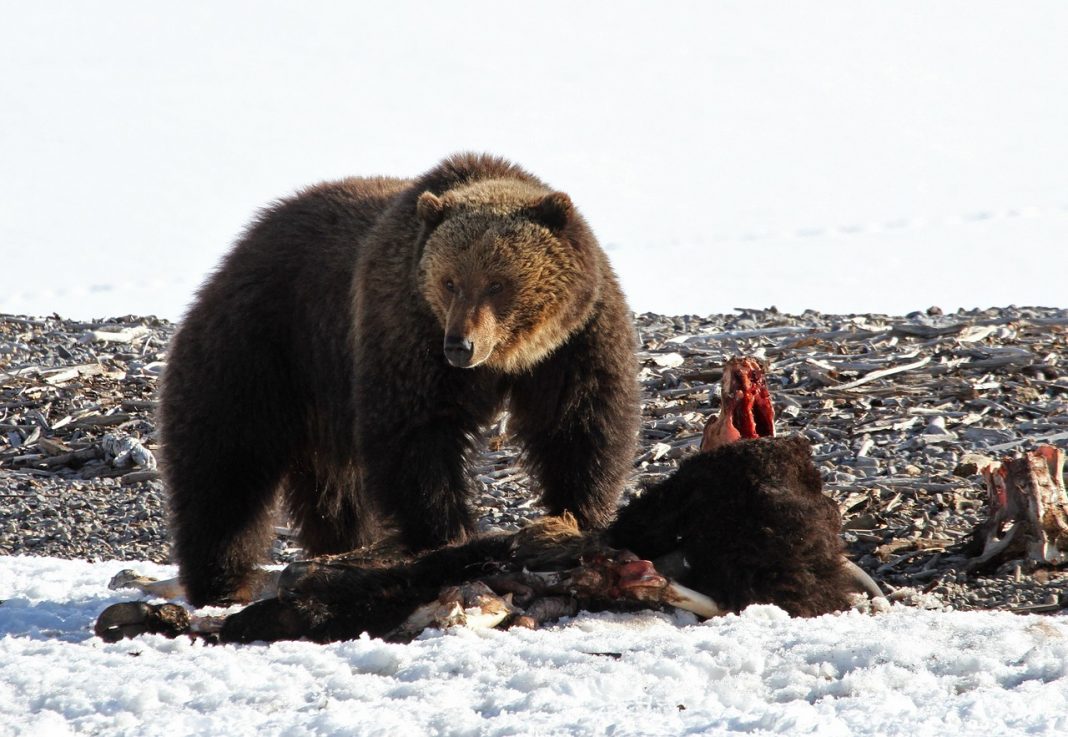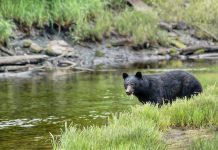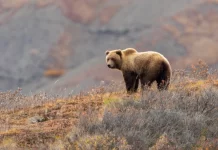No animal (excluding, possibly, the gray wolf) of the Rocky Mountain west is more polarizing and passionately debated than the grizzly bear. An iconic symbol of the last ranges of the wild reaches of America, there is almost a romantic nostalgia that captivates people whenever the topic of the grizzly is brought up. Bear/human conflicts are scrutinized. Stories of the play by captivate the masses. It is the inevitable breeding ground for the two contentious groups on each side of a growing national debate.
And, the conflict and extreme difference in opinion and attitude are not subtle. Billboards are easily found in communities around Yellowstone National Park protesting and promoting the hunting of the bear. Talk in these rural communities amongst ranchers, hunters and guides often gravitate towards the topic of the bear.
Of course, they live amongst the grizzly, their outdoor activities take place in the bear’s domain. So it makes complete sense that these discussions be commonplace.
But it doesn’t stop there – the battle lines of opposing views extend far beyond the states of Wyoming, Montana and Idaho home of the Greater Yellowstone grizzly. Simply scroll through the thousands of comments you find accompanying the countless social media posts about the management of the grizzly.
The grizzly debate has been an ongoing one, but its intensity exponentially grew in 2017. In 2017 the US Fish and Wildlife Services delisted the bear, turning management back to the state level in Wyoming, Montana and Idaho. Once returned locally, the grizzly was labeled a trophy animal – and hunting seasons were implemented.
In the past two years, bears in the Yellowstone region of Montana, Wyoming, and Idaho have expanded their territory by…
Posted by ehuntr.com on Tuesday, June 4, 2019
This ruling was not a widely popular one. Before a single hunt took place (although licenses had been purchased in some states), the delisting was over-turned by Chief United States District Judge of the United States District Court for the District of Montana, Dana Christensen citing the importance of the Yellowstone grizzly to a larger national recovery effort of the species. The argument was brought forth by a coalition of non-profit organizations and Native tribes who challenged the decision.
As long as the grizzly resides on the Endangered Species List, the opinions of a national audience are diverse and passionate. If ever they are again removed, safe to say the debate won’t lose much fervor.
Understandably frustrating, the opinions of those who live outside the Greater Yellowstone Ecosystem are not well received by those who do.
Since the grizzly has been returned to their endangered status, the number of bear human conflict as well as bears whom have been euthanized is on the rise. This was an inevitable trend independent of grizzly hunting seasons, not solely because of the re-enlistment – but a reality, nonetheless.
According to the teen, he was walking down a hill when he heard a “thump” behind him. He turned around to see a bear…
Posted by ehuntr.com on Tuesday, April 9, 2019
Grizzly behavior impacted by an increasing population has changed. Generally, conflict are the result of surprise encounters, carcass defense, and sow’s protecting their young. That is no longer always the rule of thumb. Bears habituated to human presence are less weary of humans and more prone to wander into areas where problems exist. The greater the population of bears, the more occurrences of bears around people, the higher volume of habituated bears.
Recorded cases of bears walking in on more than multiple folks on the site of big game kills are on the rise as well. Regardless of sentiment or side of the isle you reside, this is not normal grizzly behavior. Two such instances took place recently in Wyoming. In the Boulder Basin area of the South Fork of the Shoshoni River in north west Wyoming a guide was severely mauled by a bear while field dressing an elk. Earlier the same year, a guide – and father of five – was fatally mauled in Jackson. Other recorded incidences of this behavior resulted in the death of the bear.
The more the grizzly population increases, the more people that work and recreate in their territory. This means one can expect reports of conflict.
Local communities close to these heavier populated grizzly areas have been forming committees. They have been holding public comment sessions all with the hopes of finding solutions and suggestions for said grizzly/human issues.
Recently Montana Governor, Steve Bullock and Montana Fish, Wildlife and Parks appointed a committee of 18 citizens to facilitate a state-wide discussion. The committee is said to be a diverse group who represent different points of view, backgrounds and use of grizzly lands.
The council will hold six to eight public meetings in various Montana communities. Public engagement is highly encouraged. The goal of the committee is to present Governor Bullock with long term management and conservation goals. In 2018 more than 100 bear/human incidents were reported. Ranging from attacks and property damages to public safety concerns in the state of Montana alone.
Regardless of public input and committee findings, at the end of the day, the federal level gets the final say. States must abide by the federal mandate.
Which means what – for you – the individual outdoors person and hunter occupying grizzly country? Bottom line – be bear aware. Know your surroundings, look for signs of bears frequenting the area and keep your head on a proverbial swivel. It’s less if, more when you will encounter them in their country.
States have mandated food requirements that you must abide by when spending the night in grizzly country. And when leaving your big game quarters hung in trees.
Pepper spray in the right circumstance deployed properly is still the best bear deterrent. A contingency plan is also highly recommended. Do not go into grizzly country without a mode of self-defense (or two).
Animal rights groups filed a petition last week that would require Wyoming and Idaho hunters to carry bear spray. Their…
Posted by ehuntr.com on Friday, April 19, 2019
The grizzly is currently in their hyperphagia state which essentially is the time they fatten themselves up shortly before hibernation. This phase of excess eating puts them in the same areas and habitat as elk – subsequently elk hunters.
I am also a fan of studying any animal you hunt or may run in to academically. There are too many books written, not only about the bear, but best practices in bear country.
Bear education and bear awareness are the best preventative measures you can equip yourself with prior to stepping foot into grizzly country.















